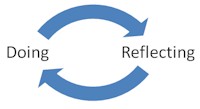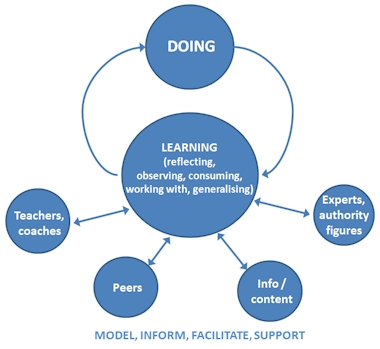![]() Throughout 2011 we will be publishing extracts from The New Learning Architect. We move on to the second part of chapter 3:
Throughout 2011 we will be publishing extracts from The New Learning Architect. We move on to the second part of chapter 3:
We go to work to do things, not to learn. Depending on how we earn our living, what this doing actually entails may be little more than repeatedly drawing upon our repertoire of learned behaviours – we’re literally on auto-pilot. More commonly, we’re also having to work at the reflective level, to analyse problems, come up with solutions, communicate with others and make decisions. Now in the process of doing all this, our behaviours will inevitably adapt and evolve to some extent with no conscious effort on our part – we learn through simple trial and error, and by our observations of the successes and failures of others. But this is a haphazard and uncontrolled way to proceed if you value your job and your career – there’s a definite risk that, regardless of the number of years that you clock up, you’ll have the same year’s experience over and over again.
So, at very least, we need our learning model to extend beyond doing:

Left to our own devices we can do quite well, thank you. But imagine how much richer our learning could become if we were able to draw upon the resources of others, who have attempted the same tasks in the past. As we look further afield for assistance, our learning model becomes correspondingly more complex:

- As we develop our network to include experts and peers, and gain access to prepared content, such as reference materials, we have the basis for just-in-time learning – learning at the point of need.
- As we extend our network to include coaches, mentors, on-job instructors and professional colleagues, and as we gain access to all manner of learning materials, we can start to get ahead of the game, to develop our knowledge and skills to meet future challenges.
- And as we build further relationships with teachers, trainers, facilitators and co-learners, we have the opportunity to formalise our learning outcomes through educational and training courses.
The people and content with whom we interact perform many useful functions:
- They model effective behaviour.
- They inform us of the facts, concepts, rules, principles, procedures and processes that underpin effective behaviour.
- They facilitate our learning by encouraging us to participate in thought-provoking and challenging activities, by introducing us to useful resources, and perhaps most importantly, by asking the right questions.
- They support and encourage us by establishing the right emotional conditions for learning and helping us out when we’re in difficulty.
Which leaves us to observe, to reflect, to consume all that content which we find for ourselves or which we are pointed towards, to work with new ideas, and to generalise about what we should do in the future. Now we’re motoring.
Coming next in chapter 3: Taking a look beneath the hood
Return to Chapter 1
Return to Chapter 2
Obtain your copy of The New Learning Architect
